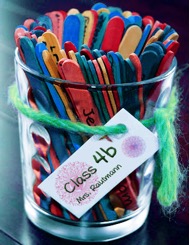Imagine the following situation: You want your students to read out their results, but you are running low on time. Your students are highly motivated, and most of them want to share their work with the class, but it is clear from the start that you can’t involve all of them. What do you do now? Pick your ‘favorite’ child? Pick the child who did the best job as an excellent example to the rest of the class? Or would it be better to involve the shy child and give her a chance to contribute to the class? Will some children feel neglected or preferred?
 Last summer, I spent three months in the United States where I’d been offered a chance to observe different elementary school classes. There I found a solution to the problem mentioned above. In one class – full of highly motivated fourth graders – I noticed a beautifully decorated jar filled with tongue depressors. At first, I couldn’t think of any purpose for this glass, so I decided to ask the teacher about it after class.
Last summer, I spent three months in the United States where I’d been offered a chance to observe different elementary school classes. There I found a solution to the problem mentioned above. In one class – full of highly motivated fourth graders – I noticed a beautifully decorated jar filled with tongue depressors. At first, I couldn’t think of any purpose for this glass, so I decided to ask the teacher about it after class.
When the teacher finished the creative writing session, she asked her students to read out their results. Time was running out, but the majority of the children wanted to read their stories. Immediately, the teacher walked over to the jar and randomly picked one stick. The student whose name appeared on the bottom of the stick got to read his story. After five draws time was up, and everyone felt that they’d had an equal chance of being chosen.
I thought that the stick jar was a useful tool, so I want to share my thoughts on possible uses with you:
- picking students fairly (alternative: If you want to equally pick boys and girls, use red sticks for girls’ names and blue sticks for boys’ names.)
- picking different students every time (Use two different jars – one for not-yet-picked and one for already-picked sticks.)
- setting up work groups with randomly selected students (Withdraw as many sticks as needed for every group.)
- setting up a random seating order in class (Withdraw sticks and put them on the tables/desks.)
- Task Jar (Students who have finished their work may pick a stick with an additional task.)
- Vocabulary Jar (Write different vocabulary on sticks either for a quick vocabulary test or for creative writing prompts, i.e. word prompt stories.)
Creating your own jars is simple, and the ways of decorating them are endless. All you need is:
- tongue depressors (one for each child in the class) or other flat sticks
- a jar or glass
- watercolors, colored markers, colorful ribbons, stickers, stamps or other decoration
If you don’t have the time to create your own stick jar, there’s an app for that.
Have fun using this method!
20,654 Total Views, 3 Views Today






